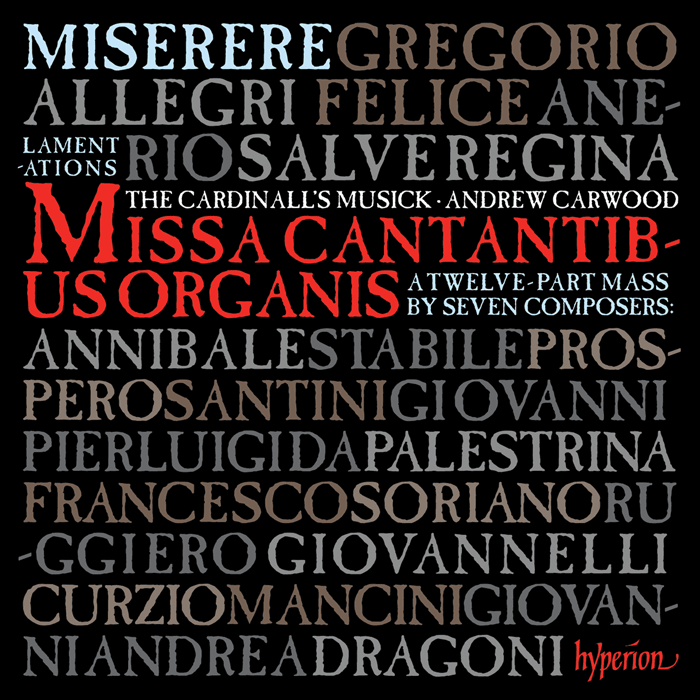Logowanie
Mikołaj - ten to ma gest!
Miles Davis, Horace Silver, Jay Jay Johnson, Percy Heath, Kenny Clarke, Lucky Thompson
Walkin'
20bit K2Super Coding - ale jak to brzmi!
Kasety magnetofonowe
Winylowy niezbędnik
ClearAudio
Double Matrix Professional - Sonic
najbardziej inteligentna i skuteczna pralka do płyt winylowych wszelkiego typu - całkowicie automatyczna
ALLEGRI, The Cardinall's Musick, Andrew Carwood
Miserere and the music of Rome
- 1 Salve regina [4'09] Felice Anerio (c1560-1614)
- Missa Cantantibus organis Giovanni Pierluigi da Palestrina (1525 /6-1594) & Annibale Stabile (c1535-1595)
- 2 Movement 1a: Kyrie eleison (Stabile) [1'29]
- 3 Movement 1b: Christe eleison (Soriano) [1'07]
- 4 Movement 1c: Kyrie eleison (Dragoni) [2'12]
- 5 Movement 2a: Gloria (Palestrina) [2'08]
- 6 Movement 2b: Domine Deus, Agnus Dei (Anonymous) [1'55]
- 7 Movement 2c: Qui tollis peccata mundi (Dragoni) [2'57]
- 8 Movement 3a: Credo (Stabile) [3'59]
- 9 Movement 3b: Crucifixus (Stabile) [2'20]
- 10 Movement 3c: Et ascendit in caelum (Soriano) [1'53]
- 11 Movement 3d: Et in Spiritum Sanctum (Giovannelli) [3'21]
- 12 Movement 4: Sanctus (Santini) [3'28]
- 13 Movement 5: Agnus Dei (Mancini) [2'25]
- 14 De lamentatione Jeremiae prophetae [4'38] Gregorio Allegri (1582-1652)
- 15 Miserere mei, Deus [12'35] Gregorio Allegri (1582-1652)
- 16 Incipit lamentatio Jeremiae prophetae [5'01] Gregorio Allegri (1582-1652)
- 17 Cantantibus organis [6'19] Giovanni Pierluigi da Palestrina (1525 /6-1594)
- 18 Gustate et videte [5'23] Gregorio Allegri (1582-1652)
- The Cardinall's Musick - orchestra
- Andrew Carwood - conductor
- ALLEGRI
The Cardinall’s Musick finished 2010 in a blaze of glory with their Gramophone Recording of the Year award for the last volume of their Byrd Edition. Only the second time in thirty years that an Early Music recording has received this prestigious accolade, it is a fitting tribute to the soaring artistry of the group and their director, Andrew Carwood. Their eagerly-awaited next disc features music from late sixteenth-century Rome and ranges from Allegri’s Miserere, surely the best-known and best-loved work of this period, to a rarely-performed or recorded oddity. Seven Roman musicians came together (or were brought together) to write a Mass-setting where they each contributed different sections. The resulting work, the twelve-voice Missa Cantantibus organis, is a tribute both to Cecilia (the patron saint of music) and to Palestrina. The seven composers each take themes found in Palestrina’s motet of the same name and use them as the starting point for their new compositions. Palestrina himself is among the seven, with Giovanni Andrea Dragoni, Ruggiero Giovannelli, Curzio Mancini, Prospero Santini, Francesco Soriano and Annibale Stabile being the other six. All seven composers were prominent maestri in Rome and most appear to have had contact with Palestrina either as choristers or pupils. ------------------------------------------------------- 'This is a really engaging trip to Rome ancient and modern, familiar and rare, full of changing textures and styles matched by pleasingly varied performances' (International Record Review) 'The Cardinall's Musick proceed to give the Miserere perhaps its finest recorded performance. Using female sopranos as he does is of course inauthentic, but Carwood is vindicated by their bell-like clarity and thrilling projection, way beyond anything you could get from boy trebles … The triumphant success of this disc is much enhanced by the vividness of the recording' (Mail on Sunday) 'This is all really exciting stuff and should be heard by anybody who cares about music of the late-16th century' (Gramophone) 'The chief delight of this new treasure from The Cardinall's Musick is not the titular Miserere but the Missa Cantantibus Organis, an extraordinary 12 part mass by seven composers, written as a tribute to Cecilia, patron saint of music … sung here with the brilliance and clarity we have come to expect from this outstanding ensemble' (The Observer) 'This recording's breadth of moods, devices and styles is refreshing. As a compendium of practices, the Mass gives vocalists many opportunities to dazzle the listener, whether through finely-wrought imitation, diversity of texture, or triumphant confluence of three choirs into one. Thanks to Andrew Carwood's directorship, the contrasting effects of these practices are immediately audible … More importantly, the vocalists use declamation to emote, transporting the listener from sorrow to transcendent joy' (BBC Music Magazine)































